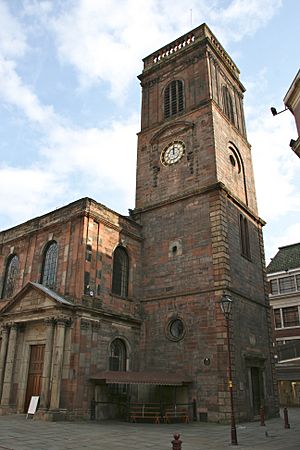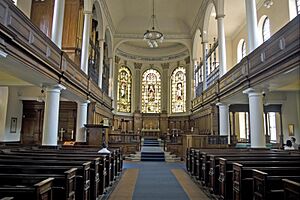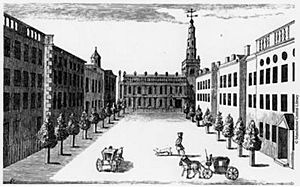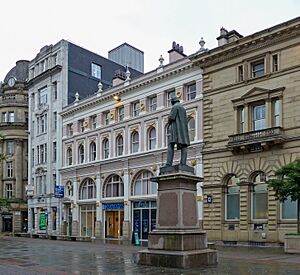St Ann's Church, Manchester facts for kids
Quick facts for kids St Ann's Church |
|
|---|---|
| The Parish Church of St Ann | |
 |
|
| Location | Manchester |
| Country | England |
| Denomination | Church of England |
| Churchmanship | Broad Church |
| Website | Church website |
| History | |
| Dedication | St Anne |
| Consecrated | 17 July 1712 |
| Architecture | |
| Functional status | Active |
| Style | Classical architecture |
| Groundbreaking | 18 May 1709 |
| Administration | |
| Parish | St Ann's |
| Archdeaconry | Manchester |
| Diocese | Manchester |
| Province | York |
St Ann's Church is a beautiful Church of England church located in Manchester, England. It's named after Saint Anne, who was the mother of the Virgin Mary. But it also honors Ann, Lady Bland, who helped start the church. This church is a very important historical building. It is a Grade I listed building, which means it's considered one of the most important historic buildings in England.
Contents
Church Design and Location
In the early 1700s, Manchester was a small town, almost like a village. It had many fields and houses made of wood. A large cornfield called Acres Field became the place where St Ann's Church was built. Today, this area is known as St Ann's Square. Acres Field used to host a yearly fair from the 1200s until 1823.
The church was built between the main market and the collegiate church. You could see its tower from all directions. St Ann's Church is a neo-classical building. It was first made from red Collyhurst sandstone, which was found nearby. However, this stone was soft and wore away easily. So, much of it has been replaced with stronger sandstone from other places like Parbold and Runcorn.
When the church was first built, its inside was quite simple. It had plain glass windows. But in the 1800s, many changes were made. Beautiful stained glass windows were added. Some of these were made specially for St Ann's. Others were moved from different churches. One special window on the north side was designed by William Peckitt from York. Inside, you can also see a unique Queen Anne altar table. There is also a famous painting called "The Descent from the Cross" by Annibale Carracci.
The church's tower is very important to Manchester. Surveyors used it to measure distances to other parts of the city. You can still see their special mark, called a benchmark, near the tower door.
Buildings in St Ann's Square
At one corner of St Ann's Square, you can see the Royal Bank of Scotland building. It was built in 1848 and looks like an Italian palace. The square also has two statues. One is of Richard Cobden, made in 1867. The other is the Boer War Memorial, created in 1907.
Church History
How St Ann's Church Began
The Mosley family were important landowners in Manchester. In 1693, Lady Ann Bland inherited the land. Lady Bland was a very fashionable person in Manchester. She had strong religious and political beliefs. She first went to a Presbyterian church. But in 1695, the church's leader died. Lady Bland then decided to start her own church.
In 1708, people asked Parliament for permission to build a new church. This was because Manchester's population was growing very fast. On May 18, 1709, Lady Bland laid the first stone for the new church. It was built at one end of Acres Field. On July 17, 1712, the church was officially opened by the Bishop of Chester. It was named after Saint Anne, the mother of the Virgin Mary. This name honored both Lady Bland and the queen at the time, Queen Anne. Lady Bland herself is buried in the Church of St James, Didsbury. There is a special plaque there to remember her life.
John Byrom and the Church
Because St Ann's was close to the collegiate church, it became popular to visit both. People would go to "the old church" in the morning and "the new church" in the afternoon. One famous person who did this was John Byrom (1692–1763). He wrote the well-known hymn Christians Awake. John Byrom was very involved with St Ann's Church, even though he supported the Jacobites.
Manchester's Growth and St Ann's
By the late 1600s, more streets were appearing around the St Ann's area. By 1720, St Ann's Square was created. It had trees, just like the fancy squares in London and Bath. In 1729, Sir Oswald Mosley built an exchange nearby. By 1735, buildings started to appear on the south side of Acres Field. Streets like King Street were built.
Manchester grew very quickly because of the Industrial Revolution. This led to many new churches being built. Later, as people moved to the suburbs, many of these churches were taken down. St Ann's Church now holds memorials from some of these lost churches. For example, it has memorials from St Matthew's, Campfield, which was designed by Sir Charles Barry.
St Ann's Role in City Life
St Ann's Church has always been important to Manchester's public life. Its rectors have often served as chaplains for the Lord Mayor and the police. In 1975, a group called the Friends of St Ann's Church was formed. This group, made up of local businesses, helps keep this historic building in good condition.
In 2011, the church underwent renovation work. This included fixing its clock, bell, stonework, and roof. The church stayed open during this time. During the work, large advertising banners covered the church. This caused some discussion because it is a Grade I listed building.
St Ann's Church also has a busy schedule of concerts. They have weekly organ recitals at lunchtime. There are also monthly professional concerts. Students from the Royal Northern College of Music often perform piano and chamber music there. The church has a large George Sixsmith organ with four manuals.
See also
- Grade I listed churches in Greater Manchester
- Listed buildings in Manchester-M2
- List of ecclesiastical works by Alfred Waterhouse




